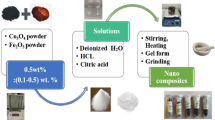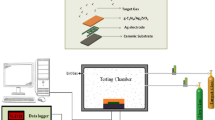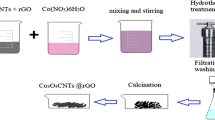Abstract
Here in this research, Activated Carbon (AC)-γFe2O3 composite structures were prepared by pyrolysis of bamboo at 700–1000 °C temperatures. Characterization of the as-obtained samples by field-emission scanning electron microscopy, Raman spectroscopy, and X-ray diffraction analysis confirmed the formation of AC-γFe2O3 composite. The alcohol sensing performance of the composite structure at room temperature was investigated for different ethanol concentrations, which showed self-activated faster response/recovery, improved range of detection, and sensitivity. Ethanol sensing by the drop-casted AC-γFe2O3 films on a glass substrate was tested for various ethanol concentrations ranging from 50 to 500 ppm in water. The chemiresistive p-n-type heterojunctions formed between AC and γFe2O3 were attributed to the room temperature alcohol sensing performance of the material. AC-γFe2O3 prepared at 700 °C showed better sensitivity of 49% for 500 ppm ethanol concentration. The quickest response time was found to be 26 s for 100 ppm ethanol concentration with a recovery time of 15 s.
Graphical abstract









Similar content being viewed by others
Abbreviations
- AC:
-
Activated carbon
- GO:
-
Graphene oxide
- rGO:
-
Reduced graphene oxide
- FESEM:
-
Field-emission scanning electron microscopy
- XRD:
-
X-ray diffraction
References
A.W. Jones, Alcohol, its analysis in blood and breath for forensic purposes, impairment effects, and acute toxicity. Wiley Interdiscip. Rev.: Forens. Sci. 1(6), 1353 (2019). https://doi.org/10.1002/wfs2.1353
A. Umar, A.A. Ibrahim, R. Kumar, H. Albargi, M.A. Alsaiari, F. Ahmed, Cubic shaped hematite (α-Fe2O3) micro-structures composed of stacked nanosheets for rapid ethanol sensor application. Sens. Actuators, B Chem. 326, 128851 (2021). https://doi.org/10.1016/j.snb.2020.128851
V. Kumar, P.K. Tyagi, Potential application of multi-walled carbon nanotubes/activated carbon/bamboo charcoal for efficient alcohol sensing. J. Alloy. Compd. 767, 215–222 (2018). https://doi.org/10.1016/j.jallcom.2018.06.123
R. Boroujerdi, A. Abdelkader, R. Paul, State of the art in alcohol sensing with 2D materials. Nano-Micro Lett. 12(1), 1–33 (2020). https://doi.org/10.1007/s40820-019-0363-0
Q.A. Khan, A. Shaur, T.A. Khan, Y.F. Joya, M.S. Awan, Characterization of reduced graphene oxide produced through a modified Hoffman method. Cogent Chem. 3(1), 1298980 (2017). https://doi.org/10.1080/23312009.2017.1298980
O.C. Compton, S.T. Nguyen, Graphene oxide, highly reduced graphene oxide, and graphene: versatile building blocks for carbon-based materials. Small 6(6), 711–723 (2010). https://doi.org/10.1002/smll.200901934
B. Li, X. Weng, X. Sun, Y. Zhang, X. Lv, G. Gu, Facile synthesis of Fe3O4/reduced graphene oxide/polyvinyl pyrrolidone ternary composites and their enhanced microwave absorbing properties. J. Saudi Chem. Soc. 22(8), 979–984 (2018). https://doi.org/10.1016/j.jscs.2018.02.006
M.H. Al-Saleh, W.H. Saadeh, U. Sundararaj, EMI shielding effectiveness of carbon based nanostructured polymeric materials: a comparative study. Carbon 60, 146–156 (2013). https://doi.org/10.1016/j.carbon.2013.04.008
A. Ahmadivand, Tunneling plasmonics: vacuum rabi oscillations in carbon nanotube mediated electromigrated nanojunctions. J. Phys. Chem. C 125(1), 782–791 (2020). https://doi.org/10.1021/acs.jpcc.0c09325
Y. Luo, E.D. Ahmadi, K. Shayan, Y. Ma, K.S. Mistry, C. Zhang, J. Hone, J.L. Blackburn, S. Strauf, Purcell-enhanced quantum yield from carbon nanotube excitons coupled to plasmonic nanocavities. Nat. Commun. 8(1), 1–9 (2017). https://doi.org/10.1038/s41467-017-01777-w
I.Y. Bu, J. Zheng, A new type of counter electrode for dye sensitized solar cells based on solution processed SnO2 and activated carbon. Mater. Sci. Semicond. Process. 39, 223–228 (2015). https://doi.org/10.1016/j.mssp.2015.04.029
S. Zhang, M. Zheng, Z. Lin, N. Li, Y. Liu, B. Zhao, H. Pang, J. Cao, P. He, Y. Shi, Activated carbon with ultrahigh specific surface area synthesized from natural plant material for lithium–sulfur batteries. J. Mater. Chem. A 2(38), 15889–15896 (2014). https://doi.org/10.1039/C4TA03503H
M.S. Reza, C.S. Yun, S. Afroze, N. Radenahmad, M.S.A. Bakar, R. Saidur, J. Taweekun, A.K. Azad, Preparation of activated carbon from biomass and its’ applications in water and gas purification, a review. Arab J. Basic Appl. Sci. 27(1), 208–238 (2020). https://doi.org/10.1080/25765299.2020.1766799
G. Nandamuri, S. Roumimov, R. Solanki, Chemical vapor deposition of graphene films. Nanotechnology 21(14), 145604 (2010). https://doi.org/10.1088/0957-4484/21/14/145604
L.M. Viculis, J.J. Mack, O.M. Mayer, H.T. Hahn, R.B. Kaner, Intercalation and exfoliation routes to graphite nanoplatelets. J. Mater. Chem. 15(9), 974–978 (2005). https://doi.org/10.1039/B413029D
U. Kamran, Y.J. Heo, J.W. Lee, S.J. Park, Functionalized carbon materials for electronic devices: a review. Micromachines (Basel) 10(4), 871 (2019). https://doi.org/10.3390/mi10040234
G. Speranza, The role of functionalization in the applications of carbon materials: an overview. C–J. Carbon Res. 5(4), 84 (2019). https://doi.org/10.3390/c5040084
H.A. Hamouda, S. Cui, X. Dai, L. Xiao, X. Xie, H. Peng, G. Ma, Synthesis of porous carbon material based on biomass derived from hibiscus sabdariffa fruits as active electrodes for high-performance symmetric supercapacitors. RSC Adv. 11(1), 354–363 (2021). https://doi.org/10.1039/D0RA09509E
S. Nasir, M.Z. Hussein, Z. Zainal, N.A. Yusof, Carbon-based nanomaterials/allotropes: a glimpse of their synthesis, properties and some applications. Materials 11(2), 295 (2018). https://doi.org/10.3390/ma11020295
A. Ibrahim, M.H. Abdel-Aziz, M.S. Zoromba, A.F. Al-Hossainy, Structural, optical, and electrical properties of multi-walled carbon nanotubes/polyaniline/Fe3O4 ternary nanocomposites thin film. Synth. Met. 238, 1–13 (2018). https://doi.org/10.1016/j.synthmet.2018.02.006
A.F. Al-Hossainy, A.A.I. Abd-Elmageed, A.T.A. Ibrahim, Synthesis, structural and optical properties of gold nanoparticle-graphene-selenocysteine composite bismuth ultrathin film electrode and its application to Pb (II) and Cd (II) determination. Arab. J. Chem. 12(8), 2853–2863 (2019). https://doi.org/10.1016/j.arabjc.2015.06.020
H.Y. Alolaywi, S. Duanghathaipornsuk, S.S. Kim, C.H. Li, J. Jinschek, D.S. Kim, A.C. Alba-Rubio, Electrochemical MoOx/Carbon nanocomposite-based gas sensor for formaldehyde detection at room temperature. J. Electrochem. Soc. 168, 067525 (2021). https://doi.org/10.1149/1945-7111/ac0d3c
Y.H. Ngo, M. Brothers, J.A. Martin, C.C. Grigsby, K. Fullerton, R.R. Naik, S.S. Kim, Chemically enhanced polymer-coated carbon nanotube electronic gas sensor for isopropyl alcohol detection. ACS Omega 3(6), 6230–6236 (2018). https://doi.org/10.1021/acsomega.8b01039
J. Kong, N.R. Franklin, C. Zhou, M.G. Chapline, S. Peng, K. Cho, H. Dai, Nanotube molecular wires as chemical sensors. Science 287(5453), 622–625 (2000). https://doi.org/10.1126/science.287.5453.622
E.S. Snow, F.K. Perkins, E.J. Houser, S.C. Badescu, T.L. Reinecke, Chemical detection with a single-walled carbon nanotube capacitor. Science 307(5717), 1942–1945 (2005). https://doi.org/10.1126/science.1109128
D. Eder, Carbon nanotube− inorganic hybrids. Chem. Rev. 110(3), 1348–1385 (2010). https://doi.org/10.1021/cr800433k
K. Movlaee, M.R. Ganjali, P. Norouzi, G. Neri, Iron-based nanomaterials/graphene composites for advanced electrochemical sensors. Nanomaterials 7(12), 406 (2017). https://doi.org/10.3390/nano7120406
S.G. Leonardi, A. Mirzaei, A. Bonavita, S. Santangelo, P. Frontera, F. Pantò, P.L. Antonucci, G. Neri, A comparison of the ethanol sensing properties of α-iron oxide nanostructures prepared via the sol–gel and electrospinning techniques. Nanotechnology 27(7), 075502 (2016). https://doi.org/10.1088/0957-4484/27/7/075502
P. Muthukumaran, C. Sumathi, J. Wilson, C. Sekar, S.G. Leonardi, G. Neri, Fe2O3/Carbon nanotube-based resistive sensors for the selective ammonia gas sensing. Sens. Lett. 12(1), 17–23 (2014). https://doi.org/10.1166/sl.2014.3220
V.M. Aroutiounian, V.M. Arakelyan, G.E. Shahnazaryan, M.S. Aleksanyan, K. Hernadi, Z. Nemeth, P. Berki, Z. Papa, Z. Toth, L. Forro, The ethanol sensors made from α-Fe2O3 decorated with multiwall carbon nanotubes. Adv. Nano Res. 3(1), 1–11 (2015). https://doi.org/10.12989/anr.2015.3.1.001
P. Barathi, A. Devaraj, A. Subramania, Mesoporous carbon/α-Fe2O3 nanoleaf composites for disposable nitrite sensors and energy storage applications. ACS Omega 5(50), 32160–32170 (2020). https://doi.org/10.1021/acsomega.0c02594
N. Díez, A. Śliwak, S. Gryglewicz, B. Grzyb, G. Gryglewicz, Enhanced reduction of graphene oxide by high-pressure hydrothermal treatment. RSC Adv. 5(100), 81831–81837 (2015). https://doi.org/10.1039/C5RA14461B
X. Jiao, Y. Qiu, L. Zhang, X. Zhang, Comparison of the characteristic properties of reduced graphene oxides synthesized from natural graphites with different graphitization degrees. RSC Adv. 7(82), 52337–52344 (2017). https://doi.org/10.1039/C7RA10809E
Q. Du, M. Zheng, L. Zhang, Y. Wang, J. Chen, L. Xue, W. Dai, G. Ji, J. Cao, Preparation of functionalized graphene sheets by a low-temperature thermal exfoliation approach and their electrochemical supercapacitive behaviors. Electrochim. Acta 55(12), 3897–3903 (2010). https://doi.org/10.1016/j.electacta.2010.01.089
C. Liang, H. Liu, J. Zhou, X. Peng, H. Zhang, One-step synthesis of spherical γ-Fe2O3 nanopowders and the evaluation of their photocatalytic activity for orange I degradation. J. Chem. 2015, 791829 (2015). https://doi.org/10.1155/2015/791829
J. Bedia, M. Peñas-Garzón, A. Gómez-Avilés, J.J. Rodriguez, C. Belver, Review on activated carbons by chemical activation with FeCl3. C–J. Carbon Res. 6(2), 21 (2020). https://doi.org/10.3390/c6020021
G. Pavoski, T. Maraschin, F.D.C. Fim, N.M. Balzaretti, G.B. Galland, C.S. Moura, N.R.D.S. Basso, Few layer reduced graphene oxide: evaluation of the best experimental conditions for easy production. Mater. Res. 20, 53–61 (2016). https://doi.org/10.1590/1980-5373-MR-2015-0528
L. Shahriary, A.A. Athawale, Graphene oxide synthesized by using modified hummers approach. Int. J. Renew. Energy Environ. Eng 2(01), 58–63 (2014)
A.C. Ferrari, J.C. Meyer, V. Scardaci, C. Casiraghi, M. Lazzeri, F. Mauri, S. Piscanec, D. Jiang, K.S. Novoselov, S. Roth, A.K. Geim, Raman spectrum of graphene and graphene layers. Phys. Rev. Lett. 97(18), 187401 (2006). https://doi.org/10.1103/PhysRevLett.97.187401
R. Schönfelder, M.H. Rümmeli, W. Gruner, M. Löffler, J. Acker, V. Hoffmann, T. Gemming, B. Büchner, T. Pichler, Purification-induced sidewall functionalization of magnetically pure single-walled carbon nanotubes. Nanotechnology 18(37), 375601 (2007). https://doi.org/10.1088/0957-4484/18/37/375601
A.C. Ferrari, J. Robertson, Interpretation of Raman spectra of disordered and amorphous carbon. Phys. Rev. B 61(20), 14095 (2000). https://doi.org/10.1103/PhysRevB.61.14095
F. Tuinstra, J.L. Koenig, Raman spectrum of graphite. J. Chem. Phys. 53(3), 1126–1130 (1970). https://doi.org/10.1063/1.1674108
F.T. Johra, J.W. Lee, W.G. Jung, Facile and safe graphene preparation on solution-based platform. J. Ind. Eng. Chem. 20(5), 2883–2887 (2014). https://doi.org/10.1016/j.jiec.2013.11.022
E. Dervishi, Z. Ji, H. Htoon, M. Sykora, S.K. Doorn, Raman spectroscopy of bottom-up synthesized graphene quantum dots: size and structure dependence. Nanoscale 11(35), 16571–16581 (2019). https://doi.org/10.1039/C9NR05345J
I.K. Moon, J. Lee, R.S. Ruoff, H. Lee, Reduced graphene oxide by chemical graphitization. Nat. Commun. 1(1), 1–6 (2010). https://doi.org/10.1038/ncomms1067
R. Kumar, R. Ghosh, Selective determination of ammonia, ethanol and acetone by reduced graphene oxide-based gas sensors at room temperature. Sens. Bio-Sens. Res. 28, 100336 (2020). https://doi.org/10.1016/j.sbsr.2020.100336
B. Paulchamy, G. Arthi, B.D. Lignesh, A simple approach to stepwise synthesis of graphene oxide nanomaterial. J. Nanomed. Nanotechnol. 6(1), 1 (2015). https://doi.org/10.4172/2157-7439.1000253
J. Gao, C. Meng, D. Xie, C. Liu, H. Bao, B. Yang, M. Li, Y. Yue, Temperature dependent thermal transport in graphene paper above room temperature. Appl. Therm. Eng. 150, 1252–1259 (2019). https://doi.org/10.1016/j.applthermaleng.2019.01.098
A. Umar, A.A. Ibrahim, U.T. Nakate, H. Albargi, M.A. Alsaiari, F. Ahmed, F.A. Alharthi, A.A. Alghamdi, N. Al-Zaqri, Fabrication and characterization of CuO nanoplates based sensor device for ethanol gas sensing application. Chem. Phys. Lett. 763, 138204 (2021). https://doi.org/10.1016/j.cplett.2020.138204
A. Husain, S. Ahmad, F. Mohammad, Synthesis, characterisation and ethanol sensing application of polythiophene/graphene nanocomposite. Mater. Chem. Phys. 239, 122324 (2020). https://doi.org/10.1016/j.matchemphys.2019.122324
B.Y. Zheng, H. Zhao, A. Manjavacas, M. McClain, P. Nordlander, N.J. Halas, Distinguishing between plasmon-induced and photoexcited carriers in a device geometry. Nat. Commun. 6(1), 1–7 (2015). https://doi.org/10.1038/ncomms8797
M. Tanzid, A. Ahmadivand, R. Zhang, B. Cerjan, A. Sobhani, S. Yazdi, P. Nordlander, N.J. Halas, Combining plasmonic hot carrier generation with free carrier absorption for high-performance near-infrared silicon-based photodetection. ACS Photonics 5(9), 3472–3477 (2018). https://doi.org/10.1021/acsphotonics.8b00623
K.-E. Byun, H.-J. Chung, J. Lee, H. Yang, H.J. Song, J. Heo, D.H. Seo, S. Park, S.W. Hwang, I. Yoo, K. Kim, Graphene for true ohmic contact at metal-semiconductor junctions. Nano Lett. 13, 4001–4005 (2013). https://doi.org/10.1021/nl402367y
T. Tharsika, M. Thanihaichelvan, A.S.M.A. Haseeb, S.A. Akbar, Highly sensitive and selective ethanol sensor based on ZnO nanorod on SnO2 thin film fabricated by spray pyrolysis. Frontiers in Materials 6, 122 (2019). https://doi.org/10.3389/fmats.2019.00122
W. Zheng, Z. Li, H. Zhang, W. Wang, Y. Wang, C. Wang, Electrospinning route for α-Fe2O3 ceramic nanofibers and their gas sensing properties. Mater. Res. Bull. 44(6), 1432–1436 (2009). https://doi.org/10.1016/j.materresbull.2008.12.013
Sin, M.L., Chow, G.C., Fung, C.K., Li, W.J., Leong, P., Wong, K.W. and Lee, T., Ultra-low-power alcohol vapor sensors based on multi-walled carbon nanotube. 1st IEEE International Conference on Nano/Micro Engineered and Molecular Systems 2006; 1198–1202. DOI: https://doi.org/10.1109/NEMS.2006.334679
T. Kavinkumar, D. Sastikumar, S. Manivannan, Effect of functional groups on dielectric, optical gas sensing properties of graphene oxide and reduced graphene oxide at room temperature. RSC Adv. 5(14), 10816–10825 (2015). https://doi.org/10.1039/C4RA12766H
C. Zhang, Z.L. Hou, B.X. Zhang, H.M. Fang, S. Bi, High sensitivity self-recovery ethanol sensor based on polyporous graphene oxide/melamine composites. Carbon 137, 467–474 (2018). https://doi.org/10.1016/j.carbon.2018.05.055
S.J. Young, Z.D. Lin, C.H. Hsiao, C.S. Huang, Ethanol gas sensors composed of carbon nanotubes with adsorbed gold nanoparticles. Int. J. Electrochem. Sci 7(11), 11634–11640 (2012). https://doi.org/10.1149/2.0211710jss
Z. Li, H. Li, Z. Wu, M. Wang, J. Luo, H. Torun, P. Hu, C. Yang, M. Grundmann, X. Liu, Y. Fu, Advances in designs and mechanisms of semiconducting metal oxide nanostructures for high-precision gas sensors operated at room temperature. Mater. Horiz. 6(3), 470–506 (2019). https://doi.org/10.1039/C8MH01365A
Acknowledgements
The authors acknowledge the experimental facilities used at IISC, Bangalore and Dr. RN for his valuable help and suggestions.
Author information
Authors and Affiliations
Corresponding author
Ethics declarations
Conflict of interest
The authors declare that they have no competing financial or non-financial interests for this research work.
Additional information
Publisher's Note
Springer Nature remains neutral with regard to jurisdictional claims in published maps and institutional affiliations.
Rights and permissions
About this article
Cite this article
Jena, L., Sarangi, S.N., Soren, D. et al. Facile two step synthesis of chemiresistive sensor based on γFe2O3—activated carbon composites for room temperature alcohol vapour detection. Appl. Phys. A 128, 153 (2022). https://doi.org/10.1007/s00339-022-05311-8
Received:
Accepted:
Published:
DOI: https://doi.org/10.1007/s00339-022-05311-8




